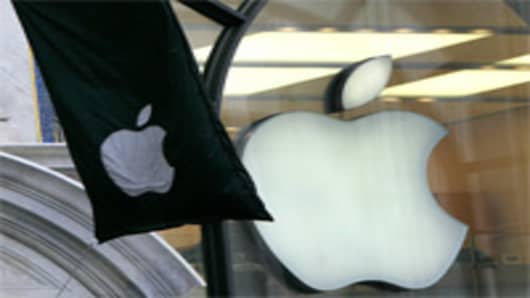Head on over to West 14th and 9th Ave. in New York's meat-packing district, and you'll see something big and bright from the fruits and veggies set: A 3-story retail bonanza courtesy of Apple Inc .
It's the company's second largest store in the nation, behind its flagship store here in nearby San Francisco, and much, much bigger than the Apple "church" on maybe retailing's most important street, the company's 5th Ave. store.
But this new store is something else. I had tape of the location fed to me yesterday to prepare for today's coverage and the images are striking; highlighted by the three-story, architecturally captivating staircase that leads all the way up to the third floor, completely devoted to Apple's "Genius Bar," which might be the industry's ultimate, in-person help desk.
The new store, opening tonight at 6 pm EST, has already generated enormous buzz. Apple fans began lining up last night, and the lines have only grown since. And today's festivities give me a chance to focus on the company's amazing retail strategy.
When Apple opened its first store back in 2001, it was met by naysayers and skeptics who claimed the Gateway strip-mall retailing model should have sent a clear message to the rest of the industry that a strategy like this could not work. Apple ignored the criticisms and went forward anyway. Building stores in top-notch locations with a clear emphasis on design, customer service, and populating the sales floor with Apple fans rather than mere retailing part-timers. And the company hasn't looked back since.
Today's store is number 204 in the Apple retailing family. The division generated more than $1 billion in revenue last quarter, over $4 billion in sales during Apple's last fiscal year. The stores hosted more than 100 million visitors over that time period.
The company plans to open 40 new locations over the next year, including Apple's first location in China. And those customers are loyal, returning far more often than customers at just about any other electronics retailer. Apple also says that 50 percent of customers buying Macs at its retail locations are first-time Mac customers. That's a key stat since it shows just how much influence these sites have in growing the Apple customer base.
Ron Johnson runs this part of Apple's business, with some on the Street claiming he's more important to Apple's long-term growth and success than Steve Jobs himself. And he's well compensated for his success. Last month, he exercised--and then sold--700,000 Apple options for a tidy, $112.9 million profit. Not bad.
Bear Stearns' Andy Neff raised his estimates yesterday in part because of what he's seeing in Apple's retailing channel. These stores were so important years ago when Apple had such tiny market share and it was searching for a way to get customers to see AND touch its products.
That's never been more important than it is today. Because it seems the more customers get a chance to play with these devices, the more likely they are to buy them. That's not to say Apple's relationship with Best Buy is a non-starter. That's important too. But Apple's own store sales aren't suffering because it sells its products elsewhere as well.
That might be good for customers; but it's great for shareholders. And tonight's opening is just the latest example of yet another Apple success story.


